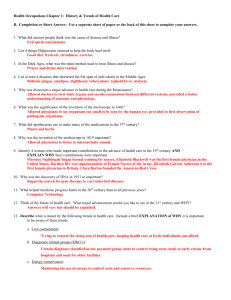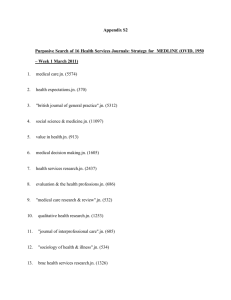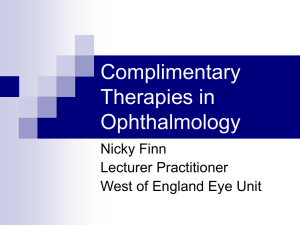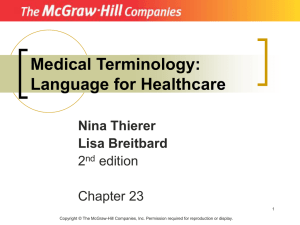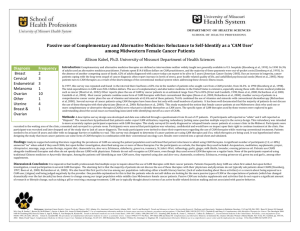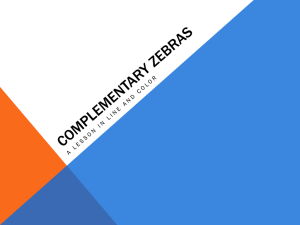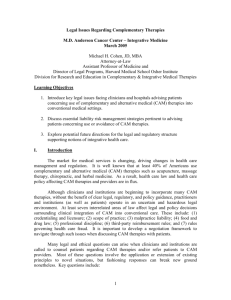Amannessay4draft
advertisement
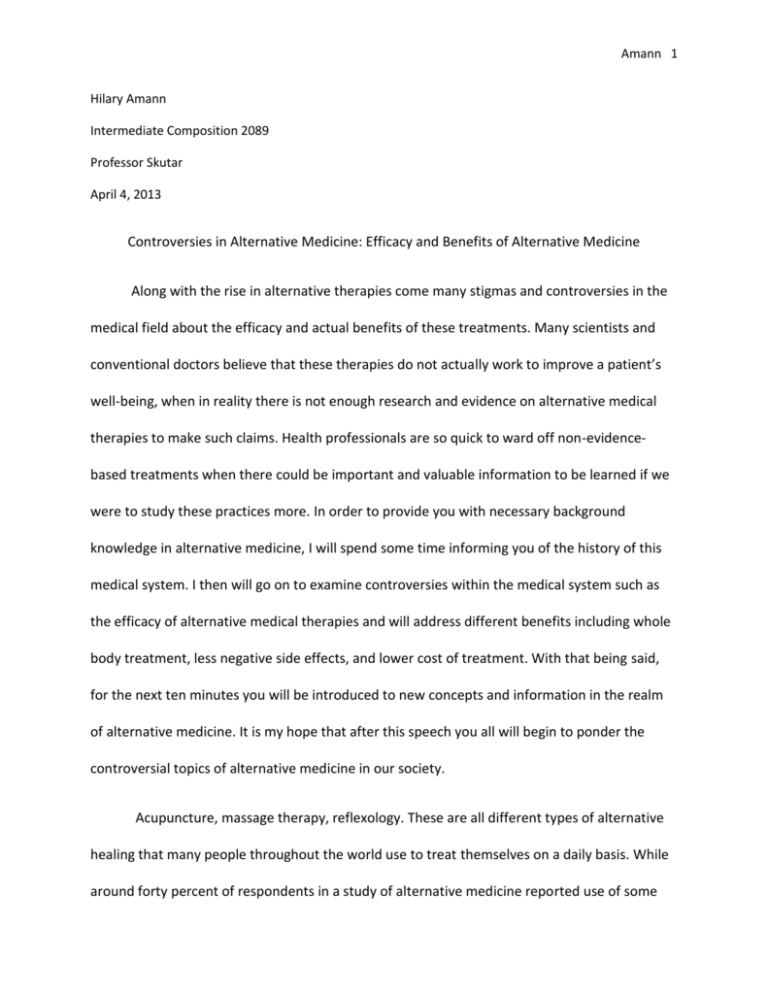
Amann 1 Hilary Amann Intermediate Composition 2089 Professor Skutar April 4, 2013 Controversies in Alternative Medicine: Efficacy and Benefits of Alternative Medicine Along with the rise in alternative therapies come many stigmas and controversies in the medical field about the efficacy and actual benefits of these treatments. Many scientists and conventional doctors believe that these therapies do not actually work to improve a patient’s well-being, when in reality there is not enough research and evidence on alternative medical therapies to make such claims. Health professionals are so quick to ward off non-evidencebased treatments when there could be important and valuable information to be learned if we were to study these practices more. In order to provide you with necessary background knowledge in alternative medicine, I will spend some time informing you of the history of this medical system. I then will go on to examine controversies within the medical system such as the efficacy of alternative medical therapies and will address different benefits including whole body treatment, less negative side effects, and lower cost of treatment. With that being said, for the next ten minutes you will be introduced to new concepts and information in the realm of alternative medicine. It is my hope that after this speech you all will begin to ponder the controversial topics of alternative medicine in our society. Acupuncture, massage therapy, reflexology. These are all different types of alternative healing that many people throughout the world use to treat themselves on a daily basis. While around forty percent of respondents in a study of alternative medicine reported use of some Amann 2 sort of alternative method of healing, there are still many controversies and questions surrounding the topic (Astin). Many questions arise when exploring the topic of alternative medicine such as does this therapy actually work or how will I benefit from the treatment? *The controversies of efficacy and health benefits of alternative medicine are important to research and spend time on because of the possibility of whole body treatments, less negative side effects, and lower cost of treatment. However, this is a very controversial subject among health professionals mainly due to the lack of evidence and research proving the benefits of these treatments as well as a lack of knowledge on the subject. In an attempt to address some controversial topics in alternative medicine, I will start off by diving into the history of alternative medicine. In the article A History of Healing Therapies: Western, Eastern, and Alternative Approaches, the author Clair Wood begins by explaining that the oldest known surgical procedure was trephination; which dates back to around 4000 BCE (Wood, 219). In this procedure the practitioner would drill a hole into the patients’ skull to treat health problems. It was believed by the ancient people that they were releasing bad spirits which were thought to be the cause of many health issues at the time. During this period “medicine was a blend of religion, magic, and the practical” (Wood, 219). Another common Egyptian saying was “may your channels be sound” which derived from the belief that blockages in the body were responsible for illness and disease. During the Roman and Greek Era around 600 BCE to 530 CE, Hippocrates and Galen dominated medicine. Hippocrates, known as the “father of medicine”, is also well known for his theory of the four humors of the body which are blood, yellow bile, black bile, and phlegm. In Amann 3 the case of an imbalance of these four humors, that is when disease enters the body. Hippocrates also believed that it was the physicians’ job to bring the bodily fluids back to a stable equilibrium with diet and drugs (Prioreschi, 320). After the death of Galen there was a movement and shift in the beliefs of traditional medicine and how it should be practiced. Prioreschi wrote in the article Alternative Medicine in Ancient and Medieval History that “physicians were considered not only greedy and dishonest, but incompetent as well, whereas the most wonderful remedies could be found in any backyard garden” (320). This leaves us to the beginning of alternative medicine. Jumping hundreds of years forward, alternative medicine in the United States is a relatively new concept. “Health care in the United States remains primarily based upon the biomedical model, yet, according to NCCAM the 2007 National Health Interview Survey concluded that approximately 38% of American adults use CAM” (Goldbas, 17). The primary forms of alternative medicine that consumers sought out were chiropractic, relaxation techniques, massage, and acupuncture (Rosenbaum, 1256.) This information isn’t too surprising because many people in our culture have massages on a fairly regular basis and don’t necessarily think of it as another form of alternative medicine, but rather just a way to relax. However, although you can see that these concepts of natural healing are deep in our world history, it still is very new to our research and American society. I read an article named Quality of Efficacy Research in Complementary and Alternative Medicine and was shocked to read that “most studies of CAM efficacy, both in adults and children, are generally of poor quality; this is true for many conventional medical practices as Amann 4 well” (Chan). When I first read that I was confused and a little discouraged, to be completely honest. I then read on to only realize that the reason for that is because the quality standards for reporting clinical trials have just begun to emerge in modern medicine. Chan then goes on to state, “In 2005, an Institute of Medicine report stated that ‘the same principles and standards of evidence of treatment effectiveness apply to all treatments, whether currently labeled as conventional medicine or CAM’”. However, one of the reason why efficacy is hard to measure is because in a lot of the treatments there needs to be patient belief and positive intentions for a good outcome. Another interesting point that Chan makes is that it is difficult to make accurate measures of the outcome of the therapy if the effect is unique to the patient, or subjective, and also if the effects depend on the skill of the practitioner. In certain treatments, there isn’t a certain ingredient that you can test to see how much is used or if it is actually working. Chan also states in the article, “Moreover, individuals often use a variety of CAM modalities simultaneously (eg, meditation, aromatherapy, herbs) or adjunctively with conventional therapies, and secular trends in lifestyle values such as diet, exercise, yoga, and massage may attenuate or magnify treatment effects.” Using these therapies in conjunction with our conventional, biomedical system would undoubtedly show nothing but positive effects. Finding some sort of common ground or a way to integrate alternative and biomedical systems would be very beneficial to our medical system. “Despite a few attempts, it has yet to be established how to integrate CAM therapies into the conventional medical system in a systematic way” (Borkan and Frenkel, 325). Many Amann 5 people have not yet tried to come up with a way to combine the two into one medical system because there are no clear and distinct guidelines of how to integrate the two. Also, there is a lack of information and research on the proper integration of alternative medicine into our modern healthcare. In this article the author talks about different methods of integrating complementary and alternative medicine into primary care. It is decided that one of the main steps in the process is insuring that there is an open and honest relationship between patient and physician. “Discussing patients’ preferences and expectations will clarify the reasons patients seek CAM, and provide clues for improving the integration of CAM into their conventional health care” (Borkan and Frenkel, 326). This also will provide physicians with valuable insight into why people are drawn to alternative medical treatments. With the patient sharing why they are interested in alternative medicine and which treatments they are planning on taking part in, it allows the physician to be able to guide them through the treatment options better. Another step in integrating the two systems is empowering the patient in the choice of treatment and including them in the different options. If the patient is clear in his or her ideas or wishes for treatment, this allows the physician to look into the modality and come up with a treatment plan that can fit to their needs. This is relevant because “the majority of those who use CAM do so because they find these health care alternatives to be more congruent with their own values, beliefs and philosophical orientations toward health and life” (Borkan and Frenkel, 327). By sharing their findings and advantages or disadvantages of treatment options, they are able to more readily make a decision together. Amann 6 Works Cited Astin, John A. "Why Patients Use Alternative Medicine: Results of a National Study.” JAMA: The Journal of the American Medical Association 279.19 (1998): 1548-1553. Web. 01 Apr. 2013. Chan, Eugenia. "Quality of Efficacy Research in Complementary and Alternative Medicine." JAMA: The Journal of the American Medical Association 299.22 (2008): 2685-686. Print. Frenkel, Moshe A., and Jeffrey M. Borkan. "An Approach for Integrating Complementary– Alternative Medicine into Primary Care." Family Practice 20.3 (2003): 324-32. Web. 1 Apr. 2013. Goldbas, Abbie. "An Introduction to Complementary and Alternative Medicine (CAM)." International Childbirth Education Association 27.3 (2012): 16-20. Web. 1 Apr. 2013. Ham, Kelli. "Complementary and Alternative Medicine: Evidence-based Resources for Consumers." Journal of Consumer Health On the Internet 13.4 (2009): 403-16. Print. Prioreschi, P. "Alternative Medicine in Ancient and Medieval History." Medical Hypotheses 55.4 (2000): 319-25. Web. 31 Mar. 2013. Rastogi, Sanjeev, and Francesco Chiappelli. "Perspectives, Protocols, Problems, and Potentials." Evidence-based Practice in Complementary and Alternative Medicine: Perspectives, Protocols, Problems, and Potential in Ayurveda. 2012 ed. Berlin: Springer, 2012. 3-29. Print. Rosenbaum, Cathy C. "The History of Complementary and Alternative Medicine in the US." Annals of Pharmacotherapy 41.7 (2007): 1256-260. Web. 25 Mar. 2013. Spencer, John W., and Joseph J. Jacobs. Complementary/Alternative Medicine: An Evidencebased Approach. St. Louis: Mosby, 1999. Print. Wood, Clair G. "A History of Healing Therapies: Western, Eastern, and Alternative Approaches." Choice 48.2 (2010): 219+. Web. 28 Mar. 2013.

